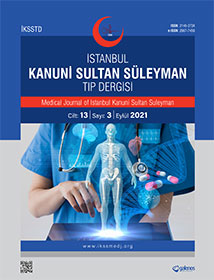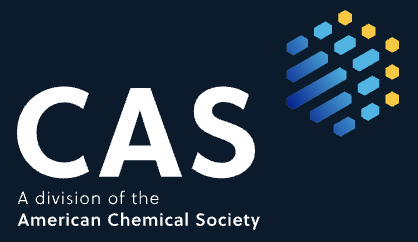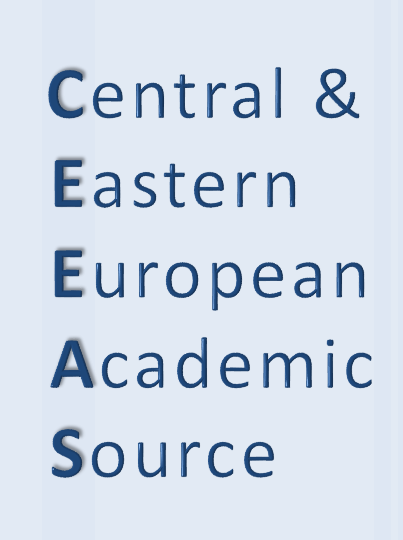Quick Search
Volume: 14 Issue: 1 - 2022
| OTHER | |
| 1. | Frontmatters Pages I - X |
| 2. | Editorial Abdussamet Bozkurt Page XI |
| RESEARCH ARTICLE | |
| 3. | Comparison of Radiofrequency Thermocoagulation Alone with Radiofrequency Thermocoagulation and Steroid Injection in Combination for the Treatment of Lower Back Pain Balkan Şahin, Salim Katar, Utku Adılay, İlhan Aydın, Melih Üçer doi: 10.14744/iksstd.2021.72335 Pages 1 - 7 INTRODUCTION: Lower back pain is the most common disease of the musculoskeletal system. Analgesics, myorelaxant drugs, bed rest, physical therapy, and conventional treatments are first-line treatments for lower back pain. In addition, conventional radiofrequency thermocoagulation (RFT) and caudal steroid injection (CSI) are common conventional therapies. The present study aims to compare the results of RFT alone with combination therapy using RFT and CSI. The effectiveness of these treatment methods in patients with chronic lower back pain is evaluated. METHODS: A total of 62 patients with lower back pain who underwent epidural CSI and RFT in neurosurgery clinic between January 2018 and May 2019 were included. RESULTS: Of the 62 patients included in the study, RFT+CSI was performed in 30 patients (48.3%). A visual analog scale (VAS) scores before and after the procedure; a statistically significant difference was only observed between the RFT+CSI and RFT group scores (p=0.030) in the sixth month after the procedure, and it was observed that the pain decreased more in the RFT+CSI group. DISCUSSION AND CONCLUSION: The present study considered body mass index (BMI), occupation, gender, age, and procedure levels. We conclude that both RFT and RFT+CSI are effective treatment methods for chronic lower back pain that does not improve after conservative or physical therapy. BMI has a direct effect on lower back pain. The VAS score decreased significantly in patients who underwent both the RFT and RFT+CSI procedures, and RFT+CSI appeared more effective in terms of the 6-month VAS score. |
| 4. | Evaluation of Clinical and Molecular Findings in a Group of Turkish Individuals with Marfan Syndrome Nihat Buğra Ağaoğlu, Özlem Akgün Doğan doi: 10.14744/iksstd.2021.08860 Pages 8 - 17 INTRODUCTION: This study aimed to review the clinical and molecular findings of 12 individuals with Marfan syndrome (MS) to identify novel mutations and associated clinical findings. METHODS: This study included 12 patients who were diagnosed with MS between January 2018 and January 2021 in a teaching and research hospital in Turkey. The patient files were retrospectively analyzed. A single clinical geneticist evaluated all of the patients. FBN1 sequencing was performed in all patients. RESULTS: There were five male and seven female patients. Four of the patients did not meet the MS clinical diagnostic criteria before the molecular analysis. Most of the patients (67%) were referred due to the aortic dilatation; however, none of the patients had aortic aneurysms/dissections. Skeletal findings and MS-related facial features were present in all of the patients. Ectopia lentis was not detected. Only one patient had a history of pneumothorax. Twelve diverse variants were detected in 12 patients. Of these, ten were classified as pathogenic and two as likely pathogenic, and three were novel and nine were previously reported. There were five nonsense (42%), four frameshift (33%), and three missense (25%) variants. FBN1 variants were distributed within the gene without any hot spots. EGF-like domain was the most commonly affected protein domain. DISCUSSION AND CONCLUSION: Elucidating the underlying molecular pathology in MS contributes to expanding the phenotype-genotype correlation in the disease and early diagnosis. Our study has broadened the genotypic and phenotypic spectrum of MS in Turkey by describing the clinical findings of 12 patients and reporting three novel variants. |
| 5. | Relationship between MMP-9 Gene Expression in Adipose Tissue and Morbid Obesity Gülşah Koç, Ahu Soyocak, İbrahim Uğur Calış, Burak Kankaya, Didem Turgut Coşan, Halil Alış doi: 10.14744/iksstd.2021.04834 Pages 18 - 22 INTRODUCTION: Obesity requires a flexible extracellular matrix (ECM) as it is characterized by adipose tissue expansion. ECM plays an important role in adipocyte development and function, lipid metabolism, and obesity. One of the most important enzymes in the remodeling of ECM is matrix metalloproteinase-9 (MMP-9). In our study, we aimed to investigate MMP-9 gene expression in adipose tissue in morbidly obese patients and to reveal their relationship with obesity. METHODS: This study comprised 44 people, 14 of whom were of normal weight and 30 were morbidly obese. MMP-9 gene expression in adipose tissue was evaluated by quantitative real time reverse transcription polymerase chain reaction (qRT PCR). The data were evaluated by statistical methods. RESULTS: MMP-9 mRNA levels were found to be slightly higher in obese patients (6.36±2.54) than healthy controls (4.41±1.03); however, this was not statistically significant (p=0.570). Furthermore, there was no difference in MMP-9 mRNA levels between men and women in both groups (p=0.925). DISCUSSION AND CONCLUSION: We showed that the MMP-9 mRNA level in visceral adipose tissue (VAT) was slightly higher in morbidly obese patients than in nonobese controls; however, the difference was not statistically significant. More research is needed to completely understand the role of MMP-9 in obesity. |
| 6. | Is WHO 2010 Pathological Classification a Guide for Neuroendocrine Tumors? Levent Eminoğlu doi: 10.14744/iksstd.2021.30633 Pages 23 - 26 INTRODUCTION: The World Health Organization (WHO) suggested a classification of neuroendocrine tumors (NETs). The aim of this study was to review the relationship of mortality and morbidity and gastrointestinal NETs with the WHO 2010 classification. METHODS: Patients who were admitted to our clinic and operated for gastrointestinal cancer were included in this study. The clinical characteristics, treatment, prognoses, mortality and morbidity, and the WHO 2010 classification were retrospectively reviewed. RESULTS: The WHO 2010 classification was used for the pathological classification. Of the total 31 patients, 16 were GEP-NET grade 1, 7 were grade 2, and 8 were grade 3. Mortality occurred in 4 patients who had multiple metastases, and therefore the operation could not be performed. These patients were grade 3 patients. Morbidity occurred in 3 patients after the operation of whom 2 were grade 2 and 1 was grade 3. DISCUSSION AND CONCLUSION: Although there are limitations, the WHO 2010 classification is convenient for patients with NETs. |
| 7. | Effectiveness of Zero-Angle Gastrojejunostomy Anastomosis Technique Applied to Pancreaticoduodenectomy on Delayed Gastric Emptying Alpen Yahya Gümüşoğlu, Hamit Ahmet Kabuli, Sezer Akbulut, Kıvanç Derya Peker, Serhan Yılmaz, Mehmet Karabulut, Gökhan Tolga Adaş doi: 10.14744/iksstd.2021.59489 Pages 27 - 34 INTRODUCTION: This study aims to investigate the effectiveness of the gastrojejunostomy anastomosis method performed at zero angle in pancreaticoduodenectomy in reducing delayed gastric emptying (DGE). METHODS: Patients who underwent a pancreaticoduodenectomy between January 2014 and July 2017 (n=57) (Group 1) and those who underwent between August 2017 and January 2020 (n=90) (Group 2) were included in this study in two groups. There were patients who consecutively underwent anastomosis with irregular angles before August 2017. Then, gastrojejunostomy was applied at zero angle. The patients were evaluated in terms of age, gender, duration of surgery, preoperative blood loss, wound site infection, postoperative bleeding, gastric emptying difficulty, American Society of Anesthesiology (ASA) score, body mass index (BMI), pancreatic fistula, and the length of hospital stay. RESULTS: A total of 147 patients were included in the study. It was shown that 14.3% of the patients had DGE. DGE was observed at a rate of 24.6% with 14 patients in Group 1 and a rate of 7.8% with 7 patients in Group 2 (p=0.019). There was no statistically significant difference in the other features of the patients. DISCUSSION AND CONCLUSION: Gastrojejunostomy performed with zero angle and one-third of resection causes significantly less DGE when compared with irregular methods. |
| 8. | What Should Be the Optimum Biopsy Time for Helicobactery Pylori in Upper Gastrointestinal System Bleeding Due to Peptic Ulcer? Cemal Seyhun, Mehmet Abdussamet Bozkurt, Bahadır Kartal doi: 10.14744/iksstd.2021.59389 Pages 35 - 42 INTRODUCTION: Upper gastrointestinal system (GIS) bleedings are common in the daily practice of general surgeons and are still an emergency situation with high mor-bidity and mortality despite advanced medical and endoscopic treatments. The most common cause of upper gastrointestinal bleeding is peptic ulcer; Helicobacter pylori (HP) has been implicated in the etiology of peptic ulcers. In this study, we aimed to determine the optimum time of biopsy for HP and the optimum time to start HP treatment in patients who applied to the hospital with upper gastrointestinal bleeding and had gastric or duodenal ulcers during their gastroscopic evaluation. METHODS: Patients who were diagnosed with upper GIS bleeding and had bleeding due to peptic ulcer disease were divided into two groups. In the first group, patients whose bleeding was stopped and who were discharged with medical therapy, and underwent biopsy for HP diagnosis from antrum after 4–6 weeks at control gastroscopy were included. In the second group, patients who underwent a biopsy for HP diagnosis from gastric antrum during the first gastroscopy performed within 6–24 h after admission were included. Endoscopic findings of patients were estimated with Forrest classification and HP densities in biopsy were estimated according to the Sydney classification, and the two groups were compared. RESULTS: When groups were divided into subgroups according to age, gender, comorbid disease, and history of previous surgery, no significant difference was found between the two groups statistically (p>0.05). When the two groups were considered in terms of rebleeding rates, no statistically significant difference was found between them (p>0.05). No statistically significant difference was found between the groups for HP according to the Sydney classification and Forrest classification in the first endoscopic evaluation (p>0.05). DISCUSSION AND CONCLUSION: In patients who presented with acute upper GIS bleeding and were hemodynamically stable and had no coagulopathy, we thought that biopsy for HP could be performed safely after bleeding was stopped regardless of the presence of active bleeding in the first endoscopy. Furthermore, biopsy for HP during the first endoscopy may help to reduce the rate of false negativity that may occur due to the proton pump inhibitor treatment that patients will use up to the control endoscopy. We think that there is a need for further studies with large series on this subject. |
| 9. | Potential Biomarkers in the Diagnosis of Hemophagocytic Syndrome in COVID-19 Patients Barış Boral, Erdinç Gülümsek, Hilmi Erdem Sümbül, Bilge Sümbül, Akkan Avcı doi: 10.14744/iksstd.2021.78095 Pages 43 - 51 INTRODUCTION: Hemofagositik Sendrom (HPS), bir COVID-19 hastasının sergileyebileceği çok ciddi immünolojik komplikasyonlardan biridir. HPS, her ikisi de ölümcül olabilen sitokin fırtınası sendromuna ve akut solunum sıkıntısı sendromuna neden olabilir. Bu çalışmanın amacı, COVID-19 hastalarında HPS'nin neden oldu-ğu immünolojik farklılıkları erken dönemde belirleyerek immünolojik komplikasyonların uygun tedavisinin sağlanabilmesidir. METHODS: Bu çalışma prospektif araştırma olarak planlandı. Başlangıçta COVID-19 nedeniyle hastaneye yatırılan HPS'si olmayan 30 hasta çalışmaya dahil edildi. Bu hastalar daha sonra HPS olup olmamasına göre iki gruba ayrıldı. Her iki grup, başvuru sırasındaki CD alt gruplari, NK ve HLA parametreler açısından incelendi. RESULTS: HFS- ve HFS+ hasta gruplarının yaş ortalaması ve cinsiyet dağılımları açısından aralarında istatistiksel olarak anlamlı değildi. AST, LDH, albümin, CD3 (%), CD19 (%) ve CD21 (MFI - ortalama floresan yoğunluğu) belirteçlerinde istatistiksel olarak anlamlı sonuçlar elde edildi. CD21 ile yapılan tek değişkenli istatistiksel analizde yaş, lenfosit sayısı, CD3 ve CD19 değerleri ile korelasyonlar bulundu. İlişkili olduğu tespit edilen bu 4 parametre ile yapılan lineer regresyon analizinde yaş ile negatif bir ilişki doğrulandı. NK hücreleri ve NK hücre alt grupları (CD56bright/CD16-, CD56dim/CD16+) incelendiğinde gruplar arasında istatistiksel olarak anlamlı bir fark bulunmadı. DISCUSSION AND CONCLUSION: CD3, CD19 ve CD21 gibi rutin laboratuvarlarda daha sık kullanılan belirteçler, COVID-19'lu HPS hastalarının erken tanısında ve tedavisinin yönetiminde faydalı olabilir. |
| 10. | Outcomes of Expectantly Managed Pregnancies with Fetal Growth Restriction and Severe Preeclampsia Deniz Kanber Açar, Salim Sezer, Özge Özdemir doi: 10.14744/iksstd.2021.91489 Pages 52 - 55 INTRODUCTION: Preeclampsia is an escalating disease involving multiple organ system characterized by hypertension and proteinuria. It is demonstrated that expectant management of severe preeclampsia improved perinatal outcomes without endangering maternal safety. Fetal growth restriction resulting from uteroplacental insufficiency is commonly associated with preeclampsia. This study is aimed to figure out the impact of fetal growth restriction on maternal and fetal outcomes. METHODS: Pregnants diagnosed with severe preeclampsia and candidates with expectant management were included in the study. Two groups were defined regarding the presence of fetal growth restriction, and the impact on fetal and maternal outcomes was compared. RESULTS: A total of 182 pregnants with severe preeclampsia of 78 associated with fetal growth restriction were included in the study. Fetal growth restriction did not have a significant effect regarding the admission to the adult intensive care unit, abruptio placenta, fetal death, eclampsia, HELLP rate, and interval between diagnosis and delivery. DISCUSSION AND CONCLUSION: Severe preeclampsia with fetal growth restriction and normal umbilical artery Doppler waveform does not preclude expectant management protocol considering the similar maternal and perinatal outcomes. |
| 11. | Mean Platelet Volume, Neutrophil/Lymphocyte Ratio, Platelet/Lymphocyte Ratio, and Early Postoperative Anesthesia Complications in Pediatric Patients Scheduled for Adenoidectomy, Tonsillectomy, and Adenotonsillectomy Şule Batçık, Leyla Kazancıoğlu doi: 10.14744/iksstd.2021.14471 Pages 56 - 62 INTRODUCTION: In our study, we aimed to examine the mean platelet volume (MPV), neutrophil/lymphocyte ratio (NLR), platelet/lymphocyte ratio (TLR), and early postoperative anesthesia complications, which are frequently used systemic inflammation markers in children who have undergone adenoidectomy, tonsil-lectomy, and adenotonsillectomy. METHODS: Our study included 203 (Group I) pediatric patients aged 2–16 years who underwent ASA1 adenoidectomy/adenotonsillectomy operation and 200 (control group-Group II) pediatric patients who were operated for different reasons. Demographic data such as age and gender of the patients, early postoper-ative anesthesia complications, preoperative white blood cell count, lymphocyte count, platelet count, hemoglobin and hematocrit levels, NLR, TLR, and MPV parameters were examined. RESULTS: The mean age was significantly higher in the tonsillectomy group than in the control group (p=0.001). There was no statistically significant difference between the two groups in terms of gender distribution (p=0.720). The number of neutrophils was statistically significantly higher in Group I compared with Group II (p=0.000). The lymphocyte count was found to be statistically significantly lower in Group I compared with Group II (p=0.011). NLR and TLR rates were found to be significantly higher in Group I compared with Group II (p=0.000 and p=0.002). The difference between the groups in terms of MPV was not statisti-cally significant (p>0.05). It was found statistically significant that the rates of hypoxia in early postoperative anesthesia complications were higher in Group I compared with Group II (p=0.001). The cut-off point of the NLR value was determined as 0.68 and the cut-off point of the TLR value was determined to be 89.6. DISCUSSION AND CONCLUSION: Preoperative NLR and TLR values were found to be high in the pediatric patient group scheduled for adenoidectomy or tonsillectomy. NLR and TLR values can be a guide in creating a careful follow-up plan in terms of increasing early postoperative anesthesia complications by recognizing this patient group, which can also be accompanied by acute or chronic inflammatory response and obstructive sleep apnea clinic. |
| 12. | The importance of blood urea nitrogen and hematological parameters according to endoscopic diagnoses and Forest Ulcer Groups in Upper Gastrointestinal System Bleeding Kader İrak, Memduh Şahin, Halil Şahin, Ali Riza Koksal, Huseyin Alkim, Canan Alkim doi: 10.14744/iksstd.2021.26032 Pages 63 - 69 INTRODUCTION: We aimed to investigate the cause and frequency of hemorrhage at the time of diagnosis of gastrointestinal bleeding in a gastroenterology clinic and analyzed the differences between some hematological parameters and blood urea nitrogen between ulcer and non-ulcer bleeding groups. METHODS: We retrospectively reviewed the data of 372 upper gastrointestinal bleeding patients who were followed between 2009 and 2021. Patients were clas-sified as ulcerated and non-ulcerated hemorrhagic groups. The ulcerated patients were further grouped as high-risk and low-risk subjects. Among patient groups, the difference between lymphocyte, hematocrit (Htc), white blood cell, neutrophil, platelet, mid platelet volume (MPV), red cell distribution width (RDW), and blood urea nitrogen (BUN) was analyzed. RESULTS: The most common diagnosed bleeding is peptic ulcer. In ulcer cases, Forrest 3 group is the most common cause of hemorrhage. BUN values are directly proportional to Forrest scores. Lymphocyte values were statistically significantly higher in the group where peptic ulcer was detected (p<0.0001). In the group without ulcers, the distribution of RDW was found to be statistically higher (p<0.0001). In the study, the BUN levels of patients with high-risk ulcers were found to be higher than those of the low-risk ulcer group. It has been determined that there is a correlation between white blood cell, neutrophil, Htc, MPV, and BUN values in patients with gastrointestinal bleeding. In addition, a positive correlation was found between the age of the cases and neutrophil, RDW, and BUN values, while a negative correlation was found between lymphocyte and Htc values. DISCUSSION AND CONCLUSION: The most common upper gastrointestinal hemorrhage cases reported in the world literature were peptic ulcers. Forrest 3 group ulcers were the most common subtype. BUN values were directly proportional to Forrest scores. In our study, non-ulcer bleeds were detected at higher ages and higher RDW values than in ulcer-derived hemorrhages. |
| 13. | Relationship of Endothelial Cell Density and Morphology with Topographic Anterior Segment Parameters in Pediatric Population Sadık Etka Bayramoğlu, Mehmet Erdoğan, Kübra Sarıcı, Gülhumar Artış, Aykut Özdemir, Nihat Sayın doi: 10.14744/iksstd.2021.46704 Pages 70 - 76 INTRODUCTION: The primary aim of the study is to investigate whether there is a relationship between endothelial cell density (ECD) and morphology with topo-graphic anterior segment parameters in the pediatric population. The secondary aim of the study is to determine the normative morphological and topograph-ic parameters of the cornea and anterior segment in a healthy pediatric Turkish population. METHODS: For the cross-sectional observational study, 73 eyes of 73 children with no ocular pathology except myopia and hyperopia up to 3 D were included. ECD, hexagonal cell ratio (HCR), and other morphological parameters were measured using the NIDEK CEM-530 specular microscopy device. Iris diameter, anterior chamber depth (ACD), anterior chamber volume (ACV), corneal volume, and other anterior segment parameters were measured using the Sirius corneal topography device. RESULTS: The mean age of 73 patients was 11±3 years. The spherical equivalent mean was –0.24±1.28 D. The mean ECD was 3253±308 cells/mm2, and the HCR was 67 6%. Mean values of iris diameter, ACD, ACV, and corneal volume were 12.2±0.3 mm, 3.8±0.2, 159±25 mm3, and 58±3 mm3, respectively. There was no statistically significant correlation between ECD and HCR with topographic anterior segment parameters. There was a negative and significant correlation between age and ECD (r=–0.55, p=0.000), but no significant correlation was found between age and HCR (p=0.26). DISCUSSION AND CONCLUSION: In the pediatric age group, there was no correlation between topographic anterior segment parameters and ECD and HCR. In the pediatric Turkish patient population, while a decrease in ECD was detected with increasing age, there was no change in HCR. |
| 14. | Radiation-Induced Pancreatic and Hematologic Injury in Gastric Tumors Gülşen Pınar Soydemir, Esengül Koçak Uzel doi: 10.14744/iksstd.2021.64426 Pages 77 - 84 INTRODUCTION: There is little information about the pancreas even though it is close to the stomach, which may be affected by radiotherapy (RT), resulting in the alteration of the pancreatic functions. We aimed to demonstrate the radiation-induced pancreatic and hematologic injury in three-dimensional conformal radiation therapy (3D-CRT) for gastric tumors by examining the data of patients with gastric cancer (GC) and who underwent chemoradiotherapy (CRT) retro-spectively, comparing the pancreatic exocrine enzymes and blood parameters between pre- and post-RT. METHODS: The data of 43 patients who were referred to our clinic with GC at stage II–IV and underwent CRT were evaluated retrospectively. Pancreatic exocrine enzymes and blood parameters were studied. These parameters were compared between pre- and post-RT. Correlation analysis was performed between the alterations in pancreatic enzyme concentrations and the pancreatic dose distribution. RESULTS: The majority of patients (95.3%) receiving RT were treated with adjuvant RT (87.8%). CRT was given to 83.7% of the cases. The mean levels of albumin, amylase, lipase, white blood cells (WBC), and platelets were significantly lowered after RT compared with pre-RT levels (p<0.05). No correlation was found between the pancreatic exocrine enzymes and pancreatic mean dose, volume, and V40 (p>0.05). DISCUSSION AND CONCLUSION: The function of the exocrine pancreas and the hematological parameters may be affected by CRT in GC patients, which may provide clues for the assessment of RT-induced toxicity. This toxicity for the pancreas is inevitably associated with side effects and complications in terms of pancreatic functions and hematological findings. |
| 15. | Pathological View of Cardiac Rupture and Myocardial Infarction Taner Daş, Aytül Buğra doi: 10.14744/iksstd.2021.31549 Pages 85 - 90 INTRODUCTION: This study aimed to investigate the cardiac rupture due to myocardial infarction. Differences between male and female sex, the most common age group, and the most common localization were investigated. In addition, we examined the dating of myocardial infarction at the site of the cardiac rupture and tried to determine the relationship between the age of myocardial infarction and cardiac rupture. METHODS: Sixty cases of myocardial rupture at the Council of Forensic Medicine between 2015 and 2020 have been studied. Three cases with traumatic causes and two cases with inadequate information were not included in the study. The age, gender, height, weight, body mass index, localization of rupture site, presence of pericarditis, presence of fibrin thrombus in coronary arteries, presence of stents or artificial valve, and a known history of hypertension, diabetes, and bypass were noted. RESULTS: Of the 55 cases included in the study, 45 (82%) were males and 10 (18%) were females. The most common site of cardiac wall rupture was the left ventricular lateral wall (n=16, 29%). Twelve cases (22%) were histopathologically associated with pericarditis. Two cases (4%) have the presence of a stent in the coronary arteries. No cases have a history of bypass surgery. DISCUSSION AND CONCLUSION: In our study, the myocardial rupture was detected most commonly in the first 24 h of myocardial infarction that is followed by between the third and seventh day of myocardial infarction. The myocardial rupture was detected with older age. In addition, ruptures in women occur at a more advanced age than in men. |
| 16. | Is Hook Plate an Ideal Method in the Treatment of Traumatic Type 3 Acromioclavicular Joint Dislocation? Bülent Kılıç, Erdal Eren doi: 10.14744/iksstd.2021.95866 Pages 91 - 96 INTRODUCTION: Treatment of type 3 acromioclavicular joint dislocation is challenging. There are many treatment choices. One of them is hook plate fixation. The most common complication of this treatment is the need for a second surgery and lysis under the acromion. This retrospective study aimed to investigate clinical and radiological results and complication rates of the hook plate application in patients with type 3 acromioclavicular joint dislocation. METHODS: This study included 18 patients diagnosed with traumatic Rockwood type III joint dislocation and fixed with an open reduction and hook plate fixation. All patients have at least 1-year follow-up. Radiological outcomes were evaluated preoperatively and postoperatively at day 1 and month 12. Postoperative functional results (Constant–Murley Shoulder Score and Visual Analog Scale) and complication rates were recorded. RESULTS: The average follow-up period of our patients was 22±10 months. The average Constant Score was 69±3 for the injured shoulders and 89±7 for the uninjured shoulders. VAS score was 3±3. Acromioclavicular joint arthrosis developed in 5 (27.7%) patients. Subacromial osteolysis was seen in 7 (38.8%) patients. In one of these 7 patients, advanced level acromial osteolysis was detected due to improper plate positioning. In 4 of these patients (22.2%), subluxation developed in the acromioclavicular joint after plate removal. DISCUSSION AND CONCLUSION: Hook plate fixation technique for acute type 3 acromioclavicular joint dislocations could be a choice but the complications should be kept in mind. Subacromial osteolysis and acromioclavicular arthrosis are common side effects, but they do not affect functional results considerably. The removal of the implant at postoperative 12–16 weeks may help overcome these problems. |
| 17. | Role of Platelets and Indices in the Clinicopathological Features of Papillary Thyroid Carcinoma Serhan Yılmaz, Hakan Bölükbaşı, Aziz Ocakoğlu, Engin Okan Yıldırım, Mehmet Abdussamet Bozkurt doi: 10.14744/iksstd.2021.94220 Pages 97 - 103 INTRODUCTION: In this study, the potential relationship between platelet (PLT) count, PLT indices (mean platelet volume [MPV] and plateletcrit [PCT]), and clinico-pathological features in patients with papillary thyroid cancer was evaluated. METHODS: A total of 196 patients diagnosed with papillary thyroid cancer after total thyroidectomy were included in the study. The preoperative PLT, MPV, and PCT values of the patients were compared with the clinicopathological features of papillary thyroid cancer obtained from pathology reports. RESULTS: The mean age of the study population was 46±12 years, and the male/female ratio was 29/167. The preoperative PLT count, mean thyroid-stimulat-ing hormone, MPV, and PCT were 288±61 cells/L, 1.9±1.4 mIU/L, 10±0.93, and 0.30%±0.06%, respectively. The preoperative PLT count, MPV, and PCT were significantly higher in patients with tumor size ≥ 1 cm (p=0.005, p=0.001, p<0.001). PLTs in the male group were found to be significantly lower compared with the female group (male: 263±62 cells/L vs female: 292±60 cells/L, p=0.024). In the presence of capsule invasion, PLT, MPV, and PCT values were significantly higher (p=0.046, p=0.021, p=0.08), whereas only PCT values were significantly higher in patients with lymphovascular invasion (p=0.045). In the presence of thyroiditis in nontumor tissue, PLT count and PCT were significantly higher (p=0.043 and p=0.001). DISCUSSION AND CONCLUSION: The measurement of PLT count and indices is cost-effective, safe, and always indicated before surgical intervention. Therefore, preoperative PLTs, MPV, and PCT could be used as a predictive marker to foresee adverse clinicopathological features in papillary thyroid carcinoma. |
| CASE REPORT | |
| 18. | Two Cases of Systemic Cat Scratch Disease Presenting with Different Complaints Burcu Çil, İlknur Kurt, Sümeyra Doğan, Fatma Deniz Aygun doi: 10.14744/iksstd.2021.97769 Pages 104 - 107 Cat scratch disease is a sporadic and self-limiting zoonotic disease of childhood. Local lymphadenitis developing after contact or scratch by a cat is the clas-sical form of the disease but rarely can lead to the development of fever of unknown origin, encephalitis, ocular, and hepatosplenic involvement. Herein, we report two cases with systemic cat scratch disease with different complaints and clinical findings. |
| 19. | Laparoscopic Management of Fitz-Hugh-Curtis Syndrome as a Result of Genital Tuberculosis in a Virgin Adolescent Girl Ecem Eren, Cihan Kaya, İsmail Alay, Fırat Halil Baytekin doi: 10.14744/iksstd.2021.47550 Pages 108 - 111 Genital tuberculosis is an important cause of infertility and peritubal and pelvic adhesions. A 17-year-old virgin girl presented with chronic pelvic pain. There were bilateral fusiform-shaped adnexal masses, with dimensions of 7×3 cm on the left side and 8×3 cm on the right side. Her surgical findings revealed bi-lateral dilated tubes and filmy adhesions between the abdominal wall and the liver capsule. Bilateral fimbrioplasty was performed for both of the tubes. The histopathological analysis detected granulomas that predict tuberculosis. |






















